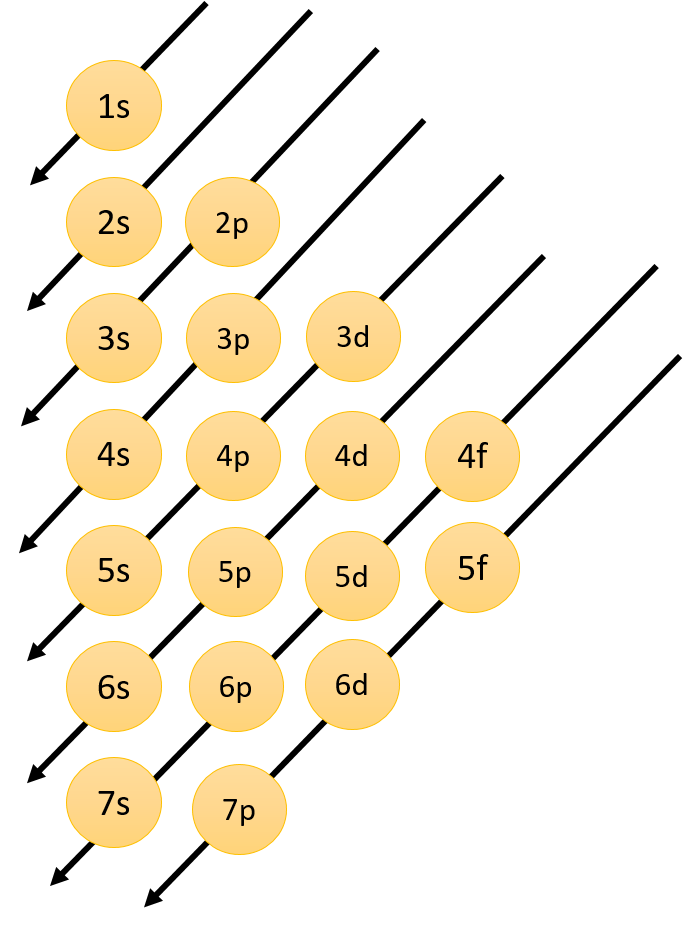
In potassium, the order of energy levels is:
(A) $3s > 3d$
(B) $4s < 3d$
(C) $4s > 4p$
(D) $4s = 3d$
Answer
129.6k+ views
Hint: The electronic configuration of potassium is $[Ar]4{s^1}$. Aufbau principle states that in the ground state of atoms, the orbitals are filled in the order of their increasing energies.
Complete step by step solution:
According to the Aufbau principle, the electrons first occupy the lowest energy orbital available to them and enter into higher energy orbitals only when the lower energy orbitals are filled. The order in which the energies of the orbitals increase and also the order in which the orbitals are filled are $1s,2s,2p,3s,3p,4s,3d,5s,4d,5p,6s,......$
This can be easily understood by the following diagram:

The energy of the orbitals depends upon the principal quantum number ($n$) and azimuthal quantum number ($l$). Orbital energy increases as ($n + l$) increases. So lower the value of ($n + l$) for an orbital, the lower is its energy. If there are two orbitals with the same value of ($n + l$) the one with the smaller value of $n$ has the lower energy.
Therefore a subshell with a lower value of ($n + l$) possess lower energy and is filled first. Let us consider $4s$ and $3d$ subshell.
For $4s$ subshell, $n + l = 4 + 0 = 4$,
while for 3d subshell, $n + l = 3 + 2 = 5$.
Hence, the ($n + l$) value of $4s$ subshell is lower than that of $3d$ subshell, so its energy is lower than that of $3d$ subshell. Thus, the $4s$ subshell is filled before the $3d$ subshell.
In the case of potassium ($K$) (atomic number ($Z$) =$19$), the electronic configuration is $1{s^2}2{s^2}2{p^6}3{s^2}3{p^6}4{s^1}$. From the electronic configuration, it can be observed that the last electron of the potassium entered into the $4s$ subshell instead of the $3d$ subshell. This is because the energy of $4s$ subshell is lower than that of $3d$ subshell as illustrated above.
Hence, option (B) is the correct answer.
Note: The energies of different orbitals drop to a different extent with an increase in atomic number because of the effective nuclear charge. The half-filled and completely filled subshells possess extra stability due to the symmetrical distribution of electrons and greater exchange energy. That is why the electronic configuration of some elements are exceptional and not in accordance with the normal order of filling. E.g., Cr ($Z = 24$) and Cu ($Z = 29$).
Complete step by step solution:
According to the Aufbau principle, the electrons first occupy the lowest energy orbital available to them and enter into higher energy orbitals only when the lower energy orbitals are filled. The order in which the energies of the orbitals increase and also the order in which the orbitals are filled are $1s,2s,2p,3s,3p,4s,3d,5s,4d,5p,6s,......$
This can be easily understood by the following diagram:

The energy of the orbitals depends upon the principal quantum number ($n$) and azimuthal quantum number ($l$). Orbital energy increases as ($n + l$) increases. So lower the value of ($n + l$) for an orbital, the lower is its energy. If there are two orbitals with the same value of ($n + l$) the one with the smaller value of $n$ has the lower energy.
Therefore a subshell with a lower value of ($n + l$) possess lower energy and is filled first. Let us consider $4s$ and $3d$ subshell.
For $4s$ subshell, $n + l = 4 + 0 = 4$,
while for 3d subshell, $n + l = 3 + 2 = 5$.
Hence, the ($n + l$) value of $4s$ subshell is lower than that of $3d$ subshell, so its energy is lower than that of $3d$ subshell. Thus, the $4s$ subshell is filled before the $3d$ subshell.
In the case of potassium ($K$) (atomic number ($Z$) =$19$), the electronic configuration is $1{s^2}2{s^2}2{p^6}3{s^2}3{p^6}4{s^1}$. From the electronic configuration, it can be observed that the last electron of the potassium entered into the $4s$ subshell instead of the $3d$ subshell. This is because the energy of $4s$ subshell is lower than that of $3d$ subshell as illustrated above.
Hence, option (B) is the correct answer.
Note: The energies of different orbitals drop to a different extent with an increase in atomic number because of the effective nuclear charge. The half-filled and completely filled subshells possess extra stability due to the symmetrical distribution of electrons and greater exchange energy. That is why the electronic configuration of some elements are exceptional and not in accordance with the normal order of filling. E.g., Cr ($Z = 24$) and Cu ($Z = 29$).
Recently Updated Pages
Difference Between Rows and Columns: JEE Main 2024

Difference Between Length and Height: JEE Main 2024

Difference Between Natural and Whole Numbers: JEE Main 2024

JEE Mains 2025 Cutoff -Qualifying Marks for NITs, IIITs & GFTIs

The probability density function pleft x right cannot class 9 maths JEE_Main

What are the products formed when moist chlorine gas class 9 chemistry JEE_Main

Trending doubts
JEE Main 2025 Session 2: Application Form (Out), Exam Dates (Released), Eligibility & More

Degree of Dissociation and Its Formula With Solved Example for JEE

JEE Main 2025: Conversion of Galvanometer Into Ammeter And Voltmeter in Physics

Learn About Angle Of Deviation In Prism: JEE Main Physics 2025

JEE Mains 2025 Correction Window Date (Out) – Check Procedure and Fees Here!

Electromagnetic Waves Chapter - Physics JEE Main

Other Pages
JEE Advanced Marks vs Ranks 2025: Understanding Category-wise Qualifying Marks and Previous Year Cut-offs

NCERT Solutions for Class 11 Chemistry Chapter 7 Redox Reaction

NCERT Solutions for Class 11 Chemistry Chapter 5 Thermodynamics

NCERT Solutions for Class 11 Chemistry Chapter 9 Hydrocarbons

NCERT Solutions for Class 11 Chemistry Chapter 8 Organic Chemistry

NCERT Solutions for Class 11 Chemistry Chapter 6 Equilibrium




